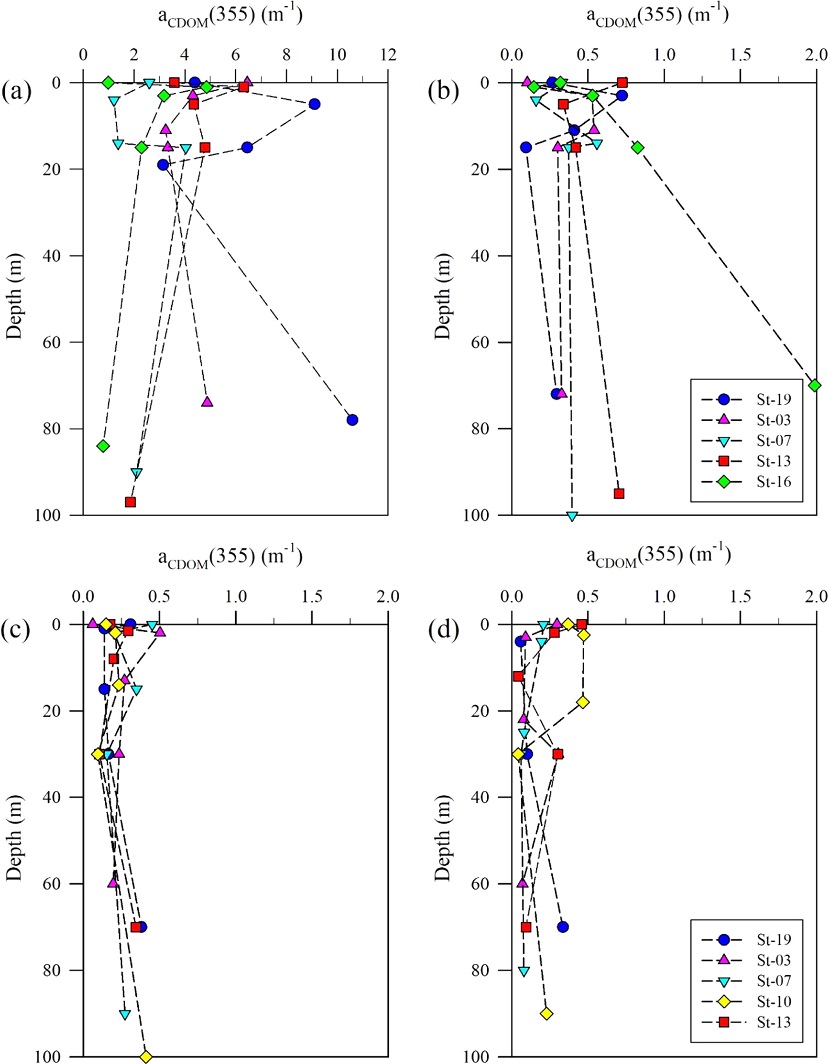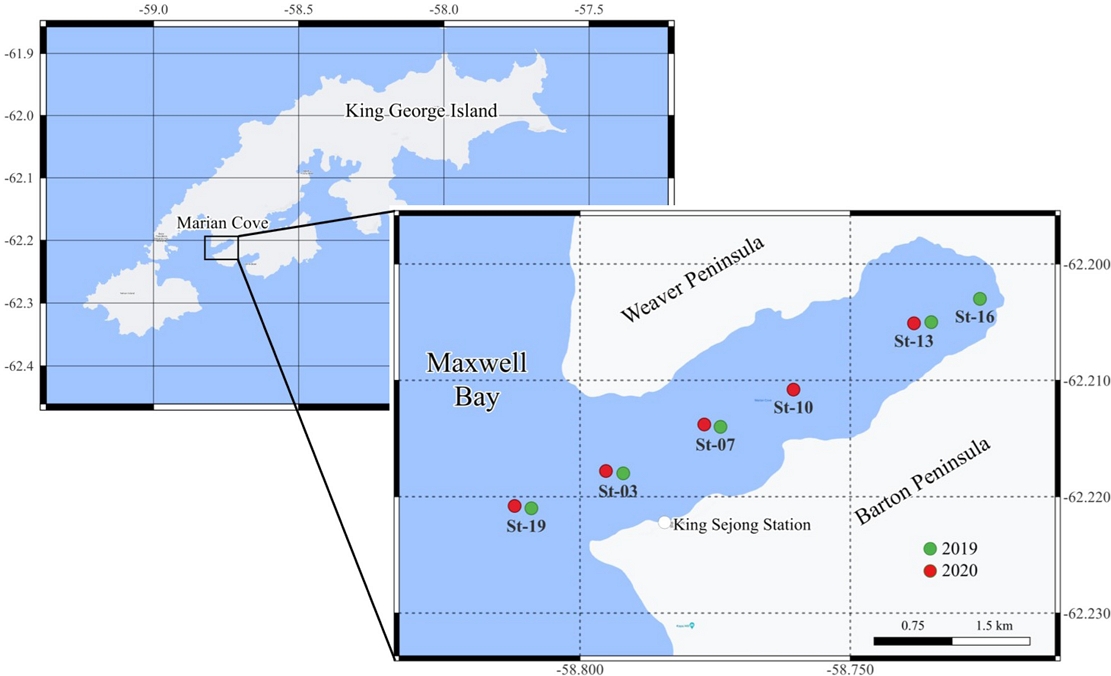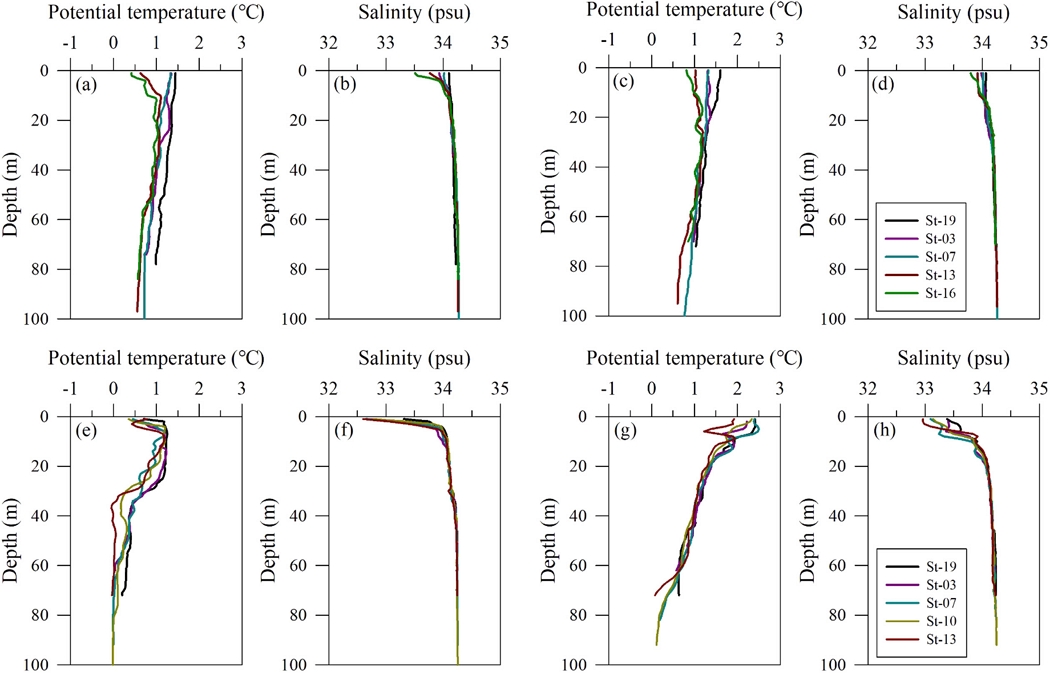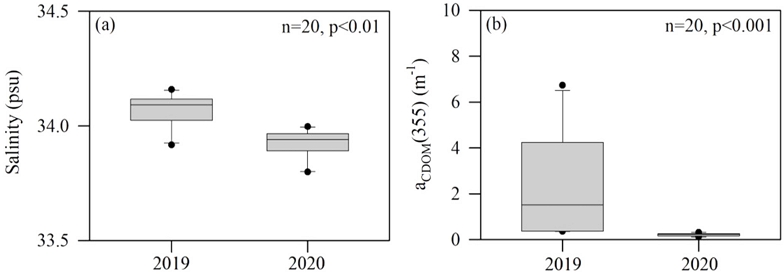
하계 남극 킹조지섬 마리안소만에서의 유색용존유기물(CDOM) 분포
초록
최근 남극은 급속한 기후변화를 겪고 있으며 이로 인해 서남극반도 킹조지섬에 위치한 마리안소만에서는 다양한 해양 환경의 변화가 나타나고 있다. 본 연구에서는 남극 마리안소만에서 2019년과 2020년 하계 기간 동안 총 4번의 현장조사를 통해 유색용존유기물(CDOM)의 시공간적 분포와 공급원을 파악하였다. 2019년과 2020년의 수온은 각각 0.42~1.44, -0.02~2.48 ℃로 관측되었으며, 염분은 2019년에는 34.1±0.16 psu, 2020년에는 33.9±0.41 psu로 관측되었다. 2020년 Chl-a 농도는 평균 0.65±0.61 μg L-1로, 2019년(평균 1.49±1.22 μg L-1)과 비교하여 약 2배 낮은 농도가 관측되었다. CDOM의 흡광도로 계산된 흡광계수 aCDOM(355)는 2019년에 0.17~10.59 m-1로 매우 넓은 범위를 보였고 2020년에는 0.04~0.50 m-1로 확연히 낮은 값이 관측되었다. CDOM과 염분 간의 유의미한 상관관계(rs=0.55, p<0.05)와 수직·수평적으로 혼합되어 있는 수괴 분포로 보아 맥스웰만의 유기물이 해류를 통해 마리안소만으로 공급되는 것으로 보이며 저층에서의 CDOM의 증가는 조류 또는 바람에 의해 발생한 퇴적물의 재부유로부터 기인한 것으로 판단된다. 본 연구 결과는 지형적으로 좁고 수심이 얕은 마리안소만에서의 유기물 변화가 물리적 변동에 의해 초래될 수 있음을 시사한다. CDOM의 장기 모니터링은 향후 기후변화로 인한 유기물 순환의 변동을 이해하기 위한 기초 자료로 활용될 수 있다.
Abstract
Rapid climate change is progressing in the Antarctic coastal area and has various influences on the environmental conditions. The spatiotemporal distribution and the source of colored dissolved organic matter (CDOM) were investigated in Marian Cove, King George Island, Antarctica, during the summer season in 2019 and 2020. The temperature in 2019 and 2020 were 0.42~1.44, -0.02~2.48 ℃, respectively, while salinity was 34.1±0.16 psu in 2019 and 33.9±0.41 psu in 2020. Phytoplankton biomass (chlorophyll-a, Chl-a) in 2020 was 1.49±1.22 μg L-1 which was two times higher than in 2019 (0.65±0.61 μg L-1). The absorption coefficient at 355 nm (aCDOM(355)) showed a wide range of 0.17~10.59 m-1 in 2019, and a significantly lower value of 0.04~0.50 m-1 in 2020. CDOM was positively correlated with salinity (rs=0.55, p<0.05) and the whole water column was vertically and horizontally well-mixed, suggesting that CDOM in Marian Cove mostly originated from the organic matter in the influent from Maxwell Bay. There may be a resuspension of sediments accompanied by tidal current or wind in the cove, which probably contributed to the increase in CDOM at the bottom. These results imply that organic matter changes in Marian Cove, which exhibits narrow and shallow topography, are mainly driven by physical factors. Long-term monitoring of CDOM may provide fundamental data for understanding climate-related organic matter cycles.
Keywords:
Colored dissolved organic matter(CDOM), Marian Cove, Antarctica, Organic matter cycle키워드:
유색용존유기물, 마리안소만, 남극, 유기물 순환1. 서 론
유색용존유기물(colored dissolved organic matter, CDOM)은 용존유기물질(dissolved organic matter) 중 광학 활성을 가진 구성요소로 자외선(ultraviolet)과 가시광선 영역에서 빛을 흡수하는 광화학적 특성을 가지고 있으며(Stedmon and Nelson[2015]), 해양의 생지화학적 순환에 영향을 미치는 광 투과 및 광화학 반응을 조절하는 역할을 한다(Zepp et al.[2007]). 특히, CDOM은 자외선을 흡수하여 식물플랑크톤의 광합성 효율을 결정하는 빛 가용성 변동을 초래하여 일차생산력을 조절함으로써 생물학적 탄소순환에 영향을 주는 것으로 보고되었다(Arrigo and Brown[1996]; Siegel et al.[2002]).
해수 내 CDOM의 공급은 대개 육상이나 담수로부터 유입되는 외부기원과 식물플랑크톤이나 박테리아로부터 합성되는 자생기원으로 분류된다(Stedmon and Nelson[2015]). 강물의 영향이 큰 연안이나 북극해의 경우 외부로부터 공급되는 CDOM이 대부분을 차지하며 고농도로 유입되는 특징을 보인다(Del Vecchio and Blough[2004]; Granskog et al.[2012]; Stedmon et al.[2011]). 자생기원 CDOM은 주로 식물플랑크톤의 광합성과(Kieber et al.[2009]; Lee et al.[2016]) 미생물의 분해 활동(Nelson et al.[1998]; [2004]) 등의 생물학적 요인에 의해 공급이 되며, 남극해에서 크릴에 의한 CDOM 공급의 가능성도 보고되었다(Ortega-Retuerta et al.[2009]). 또한 표층에서 광산화에 의해 유기물이 휴믹계 물질로 분해되거나(Kieber et al.[1997]; Ortega-Retuerta et al.[2010]) 해빙의 용융으로 인해 수층으로 CDOM이 공급되기도 하며(Norman et al.[2011]; Scully and Miller[2000]), 퇴적물의 재부유(resuspension)에 의한 CDOM의 공급이 일어나기도 한다(Coble[2007]).
최근 서남극해는 1950년대 이후로 지표수 온도가 약 1.5℃ 상승하여 급격한 기후변화를 겪고 있으며(Meredith and King[2005]; Turner et al.[2014]), 이로 인해 남극반도의 해빙의 융빙 및 빙하 후퇴 속도가 1945년 이후로 지속적으로 증가하고 있는 것으로 보고되었다(Cook et al.[2005]; Vaughan[2006]). 서남극반도 북부 킹 조지섬(King George Island)에 위치한 마리안소만(Marian Cove)은 빙하 후퇴 속도가 가속화됨(Rückamp et al.[2011])에 따라 물리적 매개변수가 급격히 변화하고 있고 이에 따른 수생태계환경 및 저서생태계의 변동이 보고되고 있다(Bae et al.[2021]; Kim et al.[2020]; Moon et al.[2014]).
남극해역에서 CDOM 분포와 관련된 연구는 주로 아문젠해(Chen et al.[2019]; Lee et al.[2016]) 및 로스해(D’Sa et al.[2021]; Kieber et al.[2009])에서 진행되어 왔으나, 본 연구지역에서 수행된 연구는 킹조지섬과 브랜드필드해협(Bransfield Strait)에서 수행된 연구(Ortega-Retuerta et al.[2010]) 및 세종과학기지 주변 해역에서 수행된 CDOM 장기모니터링의 중요성을 평가한 연구(Jeon et al.[2018])로 제한적이다. 따라서 본 연구에서는 마리안소만의 CDOM의 분포와 환경요인과의 상관성을 파악하여 유기물의 공급원과 변동을 제시함으로써 향후 기후변화와 관련된 극지방의 물질 순환 및 생물학적 생리학 연구에 적용할 수 있는 기초자료를 제시하고자 한다.
2. 재료 및 방법
2.1 연구 해역
본 연구는 서남극반도 킹조지섬의 위버반도(Weaver Peninsula)와 바톤반도(Barton Peninsula) 사이에 위치한 마리안소만(폭 1.5 km, 길이 4.5 km)에서 수행되었다(Fig. 1). 하계 마리안소만의 CDOM 분포 양상을 확인하기 위하여 2019년과 2020년 총 두 차례에 걸쳐 현장조사를 실시하였으며, 그 중 2019년 1월 31일과 2월 8일, 2020년 1월 4일과 23일 총 4번의 현장조사에서 연구 결과를 획득하였다. 맥스웰만(Maxwell Bay)으로 연결되는 소만 외측에서부터 빙벽이 위치한 내측까지 만 중앙을 따라 총 5 정점(St-19, 03, 07, 13, 16)을 선정하였고 2020년에는 빙벽에서 가장 가까운 정점인 St-16에 빙벽이 무너져 내린 유빙 잔해로 인해 접근이 어려워 5 정점(St-19, 03, 07, 10, 13)을 선정하였다(Fig. 1).
2.2 환경요인 분석
연구 해역의 수온과 염분 분포는 현장에서 CTD (SBE 19plus V2, Sea-Bird Electronics, USA)를 사용하여 관측하였다. 수층 시료 획득을 위해 각 연구 정점에서 투명도판(Secchi disk)을 이용하여 유광층의 깊이를 측정하였고 표층 상대 광량의 각각 30%와 1%에 해당하는 수심을 선정하였다. 각 정점당 표층, 30% 깊이, 1% 깊이, 중층(2019년의 경우 15 m, 2020년의 경우 30 m), 저층(바닥으로부터 10 m), 총 5개 수심에서 채수하였다.
식물플랑크톤 생체량의 지표 색소인 엽록소(chlorophyll-a, Chl-a) 농도 측정을 위해 해수 0.5 L를 유리섬유 여과지(GF/F, 0.7 μm)로 여과한 후 90% 아세톤(10 mL)으로 24시간 추출하였다. 추출된 시료는 형광측정기(Trilogy, Turner designs, USA)를 사용하여 측정하였다(Parsons et al.[1984]).
2.3 CDOM 분석
CDOM 분석을 위한 시료는 각 정점에서 획득한 해수 시료를 450 ℃에서 6시간 동안 미리 태운 GF/F로 통과시킨 후 마찬가지로 450 ℃에서 6시간 태운 40 mL 암갈색병에 넣어 분석 전까지 냉장 보관 후 현장에서 즉시 분석하였다. 분석은 10 cm 석영셀을 사용하여 분광광도계(Cary 8454, Agilent, USA)로 250~800 nm 파장대의 흡광도를 측정하였으며, 초순수로 측정한 값을 blank로 사용하였고 아래 식 (1)을 사용하여 CDOM의 흡광계수(aCDOM)를 산출하였다(Mitchell et al.[2002]).
| (1) |
A(λ)는 파장 λ에서의 흡광도를 나타내고 L은 m 단위로 환산한 셀의 길이를 나타낸다. 특정 파장에서의 aCDOM은 CDOM의 농도로서 표현되며(Stedmon and Nelson[2015]) 본 연구에서는 355 nm에 해당하는 aCDOM(355)를 사용하였다.
CDOM의 흡광도는 파장이 커질수록 지수함수적으로 감소하는 양상을 보이며(Stedmon and Nelson[2015]) 다음과 같은 식으로 표현된다(Helms et al.[2008]).
| (2) |
특정 파장대의 스펙트럼 기울기(spectral slope, S)를 통해 CDOM의 광학 특성을 파악하여 CDOM의 공급원과 구조를 파악할 수 있으며 본 연구에서는 해양환경에서 CDOM의 생지화학적 변화를 반영하는 파장대의 S값(S275-295)을 비교하였다(Helms et al.[2008]).
2.4 통계분석
이화학적 수질 분석 자료 및 CDOM 자료의 연별 평균 차이에 대한 통계적 유의성을 확인하기 위하여 SPSS Statistics 18을 사용하여 통계 분석을 수행하였다. 정규 분포가 관찰되지 않아 Mann-Whitney U test를 기반으로 중앙값 차이를 비교하였다. CDOM과 환경 요인(수온, 염분, 식물플랑크톤 Chl-a)과의 상관성을 파악하기 위하여 Spearman rank order correlation test를 진행하였다.
3. 결과 및 고찰
3.1 수온, 염분의 시공간적 분포
조사기간의 수온 및 염분 분포는 시공간적으로 넓은 범위를 보였다(Table 1, 2; Fig. 2). 2019년의 수온은 0.42~1.44℃ (평균 1.06±0.31℃)의 범위를 보였으며 염분은 33.5~34.3 psu (평균 34.1±0.16 psu)로 나타났다(Fig. 2(a-d)). 2020년의 평균 수온은 0.59±0.41℃ (-0.02~2.48℃)였으며 염분은 33.9±0.41 psu (32.8~34.3 psu)의 결과를 보였다(Fig. 2(e-h)). 조사기간 동안 수온과 염분은 마리안소만 외측에서 내측으로 갈수록 낮아지는 양상을 보였다. 또한 2019년과 2020년의 수온 분포는 통계적으로 유의미한 차이를 보이지 않았으나, 염분 분포는 유의미한 차이를 보였다(p<0.01; Fig. 4(a)). 1956/57년~2020/21년의 마리안소만의 빙붕 후퇴 속도는 27.2 m y-1로 산정되었으며 관측이 시작된 1956/57년 이래로 매년 불규칙적으로 변화한 연안 빙하 경계가 관측되고 있다(Kim et al.[2022]). 2020년에 나타난 상대적으로 낮은 표층 염분과 염분약층(halocline)은(Fig. 2(f, h)) 조류나 바람, 해빙의 용융이나 강수에 의해서가 아닌, 빙붕 후퇴로 인해 마리안소만 내측에서 공급되는 융빙수의 영향으로 나타난 것으로 판단된다(Kim et al.[2021]).

Sampling information, environmental variables, and colored dissolved organic matter (CDOM) absorption coefficients at 355 nm (aCDOM(355)) of each sample collected in Marian Cove, Antarctica in 2019 summer. T: Temperature; S: Salinity; Chl-a: Chlorophyll a
3.2 식물플랑크톤 생체량(Chl-a)
2019년의 식물플랑크톤 Chl-a 농도는 0.05~4.60 μg L-1 (평균 1.49±1.22 μg L-1)로, 1월 31일의 농도(1.20±0.87 μg L-1)보다 2월 8일의 농도(1.77±1.43 μg L-1)가 소폭 높았으나 통계분석 결과 유의미한 차이를 보이지 않았다(Mann-Whitney U test, p>0.05; Table 1). 2020년 식물플랑크톤 Chl-a의 평균 농도는 0.65±0.61 μg L-1 (0.04~2.24 μg L-1 )로 1 μg L-1 미만의 매우 낮은 농도를 보였다(Table 2). 2020년 1월 4일의 Chl-a의 평균 농도는 0.44±0.42 μg L-1였으며, 1월 23일의 Chl-a 평균 농도는 0.87±0.71 μg L-1로 관측되었다(Table 2). 2019년과 2020년의 조사기간 동안의 평균 Chl-a 농도를 비교하였을 때, 2019년에 통계적으로 유의미하게 약 2배 이상 높은 농도가 관측되었다(Mann-Whitney U test, p<0.01). 조사 시기 동안 Chl-a 농도는 맥스웰만과 근접한 외측(St-19)에서 소만 내측(St-13, 16)으로 갈수록 감소하는 경향을 보였다(Table 1, 2).

Sampling information, environmental variables, and aCDOM(355) of each sample collected in Marian Cove, Antarctica in 2020 summer
여름철 마리안소만의 표층 아래(subsurface)에는 맥스웰만의 유입수(influent)가 분포하고 온도와 염분이 낮은 빙붕의 용융수(meltwater)가 표층을 덮는 구조를 이룬다(Yoo et al.[2015]). 맥스웰만에는 상대적으로 높은 수온과 염분을 특징으로 하는 modified upper circumpolar deep water (m-UCDW)가 유입되는데 마리안소만의 외측에서도 그 영향이 나타난다(Llanillo et al.[2019]). 마리안소만 외측에서 관측된 상대적으로 따뜻한 수온은 소만 내 식물플랑크톤 생체량 증가에 기여하는 것으로 보고되었고(Kim et al.[2021]), 본 연구에서 나타난 Chl-a 농도와 수온 사이의 유의미한 상관관계(rs=0.80, p<0.001; Table 3)를 비추어 볼 때, 높은 수온의 맥스웰만 유입수가 소만 외측(St-19)의 비교적 높은 Chl-a 농도에 영향을 미쳤을 것으로 판단된다.
3.3 CDOM 흡광계수(aCDOM(355))의 수직 분포
2019년 1월 31일의 CDOM 흡광계수 aCDOM(355)는 0.78~10.59 m-1로 조사 시기 중 가장 넓은 범위를 보였으며 평균 또한 4.01±2.36 m-1로 나머지 세 시기와 비교했을 때 예외적으로 매우 높았다(Table 1; Fig. 3(a)). 모든 정점에서 수심 별로 큰 차이가 나타났으며 소만 내측의 정점인 St-13 (3.58 m-1)과 St-16 (0.98 m-1)의 경우 표층에서 낮은 값을 보였다가 광수심 30% (각각 1 m)에서 가장 높은 값을 보였다. 이후 수심이 깊어질수록 aCDOM(355)가 감소하여 저층에서 가장 낮은 값(각각 1.86, 0.78 m-1)을 보였다. 맥스웰만과 근접한 정점 St-19의 경우 수심이 깊어질수록 값이 증가하다가 저층(78 m)에서 최댓값(10.59 m-1)을 보였다.

Vertical distributions of absorption coefficient of colored dissolved organic matter (aCDOM(355)) in Marian Cove on (a) 01/31/2019, (b) 02/08/2019, (c) 01/04/2020, and (d) 01/23/2020. Note the different scales with (a) and (b), (c), (d).
조사기간 동안 마리안소만 CDOM의 광학 특성을 파악한 S275-295 값은 0.010-0.036 nm-1 (평균 0.021±0.006 nm-1)의 범위로 식물플랑크톤이 CDOM의 주요 공급원으로 보고된 이전 연구와 유사한 값을 보였다(Kieber et al.[2009]; Lee et al.[2016]). 2019년의 식물플랑크톤 대번성(bloom)은 1월 14일을 전후하여 일어났으며 Chl-a 농도 최대 19.5 mg m-3, 탄소흡수율 최대 4.52 g C m-2 day-1로 예년보다 매우 높은 값이 보고되었다(Kim et al.[2021]). 이와 같은 활발한 광합성 산물이 1월 31일의 뚜렷하게 높은 aCDOM(355)에 반영되었을 가능성을 고려하였으나 통계분석 결과 aCDOM(355)와 Chl-a는 무관함을 보였다(p>0.05; Table 3). 그러나 aCDOM(355)가 염분과는 유의미한 상관관계를 보였고(rs=0.55, p<0.05; Table 3) 수평·수직적으로 혼합되어 있는 마리안소만의 수괴 분포로 미루어 볼 때(Fig. 2(a-b)), 마리안소만의 CDOM은 식물플랑크톤에 의한 직접적인 공급이 아닌, 높은 수온과 염분을 특징으로 하는 맥스웰만 유입수(Llanillo et al.[2019])에 편승하여 공급되는 자생기원 유기물로부터 기인한 것으로 보인다. 또한 2019년 1월 31일에 관측된 St-19 저층에서의 높은 aCDOM(355)는 맥스웰만 유입수의 영향이 더 크게 나타난 결과로 판단된다(Fig. 3(a)).
2019년 2월 8일의 aCDOM(355) 범위는 0.17~1.99 m-1로 2 m-1 미만의 값을 보였으며, 본 연구 지역에서 관측된 CDOM 농도와 유사한 결과(평균 0.48±0.37 m-1)를 보였다(Jeon et al.[2018]; Ortega-Retuerta et al.[2010]). 모든 정점의 저층에서 중층보다 더 높은 값을 보였고 소만의 가장 내측 정점인 St-16에서는 저층에서 최댓값(1.99 m-1)을 보였다(Table 1; Fig. 3(b)). 선행 연구에 따르면 수직 혼합이 활발하게 이루어진 해역에서는 퇴적물이 CDOM의 공급 요인으로 보고된 바 있으며(Boss et al.[2001]; Guallar and Flos [2019]), 본 연구 지역인 마리안소만은 소만의 외측과 내측에 위치한 수중 언덕(submarine sill)에서 조류가 발생하며(Yoo et al.[2015]), 주로 조류에 의해 퇴적물의 재부유가 일어나는 것으로 알려져 있다(Khim et al.[2007]). 다만 바람과 같은 외부적인 물리 요인이 더 크게 작용할 경우 이로 인한 수괴의 물리적인 구조의 변화가 발생하는데(Yoo et al.[1999]) 강한 동풍이 지속될 경우 소만 내측에서 용승이 일어나면서 퇴적물의 재부유가 동반되기도 한다(Yoo et al.[2015]). 뿐만 아니라, 마리안소만 및 인접한 애드미랄티만(Admiralty Bay)의 상층에서 조류와 바람에 의해 재부유된 저서성 미세조류(benthic microalgae)가 보고된 바 있다(Brandini and Rebello[1994]; Kang et al.[1997]). 이와 같은 물리적 요인의 변화가 2019년 2월 8일에 다른 정점에서 나타나지 않은 소만 내측 St-16 저층에서의 aCDOM(355)의 증가(Fig. 3(b))에 반영된 것으로 판단되며 수직적으로 혼합되어 있는 수괴 구조로(Fig. 2(c-d)) 인해 그 영향이 보다 크게 나타난 것으로 보인다. 이와 같은 연구 결과는 퇴적물의 재부유로 인해 CDOM을 포함한 유기물의 공급 가능성을 암시한다.
2020년 마리안소만의 aCDOM(355) 범위는 0.04~0.05 m-1로 나타났으며, 1월 4일 St-19, 07, 10, 13에서는 중층에서보다 저층에서의 aCDOM(355)가 상대적으로 높게 나타났으며, 특히 St-19 (0.38 m-1), St-10 (0.41 m-1), St-13 (0.35 m-1)에서는 저층에서 최댓값을 보였다. St-03에서는 광량 30%에 해당하는 수심(2 m)에서 가장 높은 값(0.50 m-1)을 보였고 수심이 깊어질수록 감소하였다(Table 2; Fig. 3(c)). 1월 23일에 관측된 aCDOM(355)는 0.04~0.47 m-1로 1월 4일과 유사한 평균 0.21±0.14 m-1의 낮은 값을 보였으며, 소만 내측 정점인 St-13 (0.46 m-1)과 St-10 (0.37 m-1)의 표층에서 비교적 높은 값을 보였다(Table 2; Fig. 3(d)).
본 연구 결과에서 2020년의 aCDOM(355)는 2019년에 비해 현저히 낮은 값을 보였다(p<0.001; Fig. 4(b)). 남극해는 외부로부터 공급되는 유기물이 거의 없기 때문에(Ducklow et al.[2007]) 자생기원 CDOM이 우세하게 나타나는 것을 특징으로 한다. 식물플랑크톤 생체량을 대변하는 Chl-a가 2020년에 2019년보다 2배 이상 낮았고(Mann-Whitney U test, p<0.01) 연구기간 동안 산출된 aCDOM(355)와 Chl-a가 통계적으로 유의미한 상관관계를 보이지 않았음을 고려할 때(p>0.05; Table 3), 마리안소만 내 CDOM은 자생기원보다는 물리적 요인에 의한 변화가 더 큰 것으로 판단된다. 2020년의 염분은 2019년에 비해 낮았고(p<0.01, Fig. 4(a)) 마리안소만 내측에 위치한 빙붕으로부터 유입되는 융빙수에 의해 염분약층이 형성되었는데, 이로 인해 맥스웰만으로부터 수층 내로 유입되는 유기물의 영향이 다소 약화된 것으로 보인다(Fig. 2(f, h)). 또한, 마리안소만과 같은 좁고 얕은 만 해역에서 바람으로 인해 수온, 수괴의 안정도, 영양염의 농도 등이 조절되고 식물플랑크톤의 표층 생물량과 일차생산력의 변화로 이어진 연구 결과(Kim et al.[2022]; Jeon et al.[2021])로 미루어 볼 때, 광범위한 물리적 변화가 마리안소만의 생지화학적 변화를 야기한 것으로 판단된다.
4. 결 론
본 연구에서는 서남극반도 킹조지섬 마리안소만에서의 CDOM의 시공간적 분포를 파악하고 CDOM의 흡광계수 aCDOM(355)와 수온, 염분, Chl-a와의 비교를 통해 CDOM의 공급원을 살펴보았다. 2019년과 2020년, 총 4번의 현장조사를 실시하였고 연구 결과 CDOM은 조사 시기별, 정점별 뚜렷한 차이를 보였다. aCDOM(355)와 염분의 유의미한 양의 상관관계(rs=0.55, p<0.05)는 마리안소만의 유기물이 비교적 높은 수온과 염분을 특징으로 하는 맥스웰만의 유입수로부터 기인함을 시사한다. 소만에서 발생하는 조류나 바람으로 인한 퇴적물의 재부유를 통해 저층에서의 CDOM의 증가가 관측되었으며 마리안소만의 지역적 특성으로 인해 이와 같은 물리적 요인이 더 우세하게 나타난 것으로 판단된다. 본 연구에서는 빙붕 후퇴가 CDOM 변동에 미치는 직접적인 영향은 나타나지 않았으나 기후변화로 인한 빙붕 후퇴가 지속적으로 관측되고 있기 때문에 장기적으로 CDOM의 거동을 관측함으로써 이와 관련된 생지화학적 유기물 순환 및 생물학적 광합성 효율을 해석하는 것은 매우 중요하다. 향후 기후변화로 인한 세종기지 주변 마리안소만의 탄소순환 변동을 파악하기 위해 물리적 변화로 인한 CDOM 분포와 식물플랑크톤 광합성 효율 변동에 대한 추가적 연구가 필요할 것으로 판단된다.
Acknowledgments
본 연구는 한국해양과학기술원 부설 극지연구소 기관고유사업 “서남극해 온난화에 따른 탄소흡수력 변동 및 생태계 반응 연구(PE23110)”의 지원을 받아 수행되었습니다.
References
-
Arrigo, K.R., Brown, C.W., 1996, Impact of chromophoric dissolved organic matter on UV inhibition of primary productivity in the sea, Mar. Ecol. Prog. Ser., 140, 207-216.
[https://doi.org/10.3354/meps140207]

-
Bae, H., Ahn, I.-Y., Park, J., Song, S.J., Noh, J., Kim, H., Khim, J.S., 2021, Shift in polar benthic community structure in a fast retreating glacial area of Marian Cove, West Antarctica, Sci. Rep., 11, 241.
[https://doi.org/10.1038/s41598-020-80636-z]

-
Boss, E., Pegau, W.S., Zaneveld, J.R.V., Barnard, A.H., 2001, Spatial and temporal variability of absorption by dissolved material at a continental shelf, J. Geophys. Res., 106(C5), 9499-9507.
[https://doi.org/10.1029/2000JC900008]

-
Brandini, F.P., Rebello, J., 1994, Wind field effect on hydrography and chlorophyll dynamics in the coastal pelagial of Admiralty Bay, King George Island, Antarctica, Antarc. Sci., 6(4), 433-442.
[https://doi.org/10.1017/S0954102094000672]

-
Chen, M., Jung, J., Lee, Y.K., Kim, T.-W., Hur, J., 2019, Production of tyrosine-like fluorescence and labile chromophoric dissolved organic matter (DOM) and low surface accumulation of low molecular weight-dominated DOM in a productive Antarctic sea, Mar. Chem., 213, 40-48.
[https://doi.org/10.1016/j.marchem.2019.04.009]

-
Cook, A.J., Fox, A.J., Vaughan, D.G., Ferrigno, J.G., 2005, Retreating glacier fronts on the Antarctic Peninsula over the past half-century, Science, 308, 541-544.
[https://doi.org/10.1126/science.1104235]

-
Coble, P.G., 2007, Marine optical biogeochemistry: the chemistry of ocean color, Chem. Rev., 107, 402-418.
[https://doi.org/10.1021/cr050350+]

-
Del Vecchio, R., Blough, N.V., 2004, Spatial and seasonal distribution of chromophoric dissolved organic matter and dissolved organic carbon in the Middle Atlantic Bight, Mar. Chem., 89, 169-187.
[https://doi.org/10.1016/j.marchem.2004.02.027]

-
D’Sa, E.J., Kim, H.-C., Ha, S.-Y., Joshi, I., 2021, Ross Sea dissolved organic optical properties during an austral summer: Biophysical Influences, Front. Mar. Sci., 8:749096.
[https://doi.org/10.3389/fmars.2021.749096]

-
Ducklow, H.W., Baker, K., Martinson, D.G., Quetin, L.B., Ross, R.M., Smith, R.C., Stammerjohn, S.E., Vernet, M., Fraser, W., 2007, Marine pelagic ecosystems: the West Antarctic Peninsula, Phil. Trans. R. Soc. B., 362, 67-94.
[https://doi.org/10.1098/rstb.2006.1955]

-
Granskog, M.A., Stedmon, C., Dodd, P.A., Amon, R.M.W., Pavlov, A., de Steur, L., Hansen, E., 2012, Characteristics of colored dissolved organic matter (CDOM) in the Arctic outflow in Fram Strait: Assessing the changes and fate of terrigenous CDOM in the Arctic Ocean, J. Geophys. Res., 117(C12), 1-13.
[https://doi.org/10.1029/2012JC008075]

-
Guallar, C., Flos, J., 2019, Linking phytoplankton primary production and chromophoric dissolved organic matter in the sea. Prog. Oceanogr., 176, 102116.
[https://doi.org/10.1016/j.pocean.2019.05.008]

-
Helms, J.R., Stubbins, A., Ritchie, J.D., Minor E.C., 2008, Absorption spectral slope and slope ratios as indictors of molecular weight, source, and photobleaching of chromophoric dissolved organic matter, Limnol. Oceanogr., 53(3), 955-969.
[https://doi.org/10.4319/lo.2008.53.3.0955]

-
Jeon, M., Iriarte, J.L., Yang, E.J., Kang, S.-H., Lee, Y., Joo, H.M., Ahn, I.-Y., Park, J., Min, G.-S., Park, S.-J., 2021, Phytoplankton succession during a massive coastal diatom bloom at Marian Cove, King George Island, Antarctica, Polar Biol., 44, 1993-2010.
[https://doi.org/10.1007/s00300-021-02933-1]

-
Jeon, M.-H., Park, M.-O., Kang, S.-H., Jeon, M., 2019, Evaluation of Sejong Base as a long term monitoring site for chromophoric dissolved organic matter (CDOM) variation in the Antarctic Ocean, J. Korean Soc. Mar. Environ. Saf., 25(7), 898-905.
[https://doi.org/10.7837/kosomes.2019.25.7.898]

- Kang, S.-H., Kang, J.-S., Chung, K.-H., Lee, M.-Y., Lee, B.-Y., Chung, H., Kim, Y., Kim, D.-Y., 1997, Seasonal variation of nearshore Antarctic microalgae and environmental factors in Marian Cove, King George Island, 1996, Ocean Polar Res., 8(1, 2), 9-27.
-
Khim, B.K., Shim, J., Yoo, H.I., Kang, Y.C., Jang, Y.H., 2007, Lithogenic and biogenic particle deposition in an Antarctic coastal environment (Marian Cove, King George Island): Seasonal patterns from a sediment trap study, Estuar. Coast. Shelf Sci., 73, 111-122.
[https://doi.org/10.1016/j.ecss.2006.12.015]

-
Kieber, D.J., Toole, D.A., Kiene, R.P., 2009, Chromophoric dissolved organic matter cycling during a Ross Sea Phaeocystis antarctica bloom, in: Krupnik, I., Lang, M.A., Miller S.E. (Eds), Smithsonian at the poles: Contributions to International Polar Year science, Smithsonian Inst. Scholarly Press, Washington, 321-335.
[https://doi.org/10.5479/si.097884601X.24]

-
Kieber, R.J., Hydro, L.H., Seaton, P.J., 1997, Photooxidation of triglycerides and fatty acids in seawater: Implication toward the formation of marine humic substances. Limnol. Oceanogr., 42(6), 1454-1462.
[https://doi.org/10.4319/lo.1997.42.6.1454]

-
Kim, B.K., Jeon, M., Joo, H.M., Kim, T.-W., Park, S.-J., Park, J., Ha, S.-Y., 2021, Impact of freshwater discharge on the carbon uptake rate of phytoplankton during summer (January–February 2019) in Marian Cove, King George Island, Antarctica, Front. Mar. Sci., 8:725173.
[https://doi.org/10.3389/fmars.2021.725173]

-
Kim, B.K., Jeon, M., Park, S.-J., Kim, H.-C., Min, J.-O., Park, J., Ha, S.-Y., 2022, Variability in the carbon and nitrogen uptake rates of phytoplankton associated with wind speed and direction in the Marian Cove, Antarctica, Front. Mar. Sci., 9:887909.
[https://doi.org/10.3389/fmars.2022.887909]

-
Kim, S., Kim, J.-H., Lim, J.-H., Jeong, J.-H., Heo, J.-M., Kim, I.-N., 2020, Distribution and control of bacterial community composition in Marian Cove surface waters, King George Island, Antarctica during the summer of 2018, Microorganisms, 8(8), 1115.
[https://doi.org/10.3390/microorganisms8081115]

-
Lee, Y.C., Park, M.O., Jung, J., Yang, E.J., Lee, S.H., 2016, Taxonomic variability of phytoplankton and relationship with production of CDOM in the polynya of the Amundsen Sea, Antarctica, Deep Sea Res. Part II: Top. Stud. Oceanogr., 123, 30-41.
[https://doi.org/10.1016/j.dsr2.2015.09.002]

-
Llanillo, P.J., Aiken, C.M., Cordero, R.R., Damiani, A., Sepúlveda, E., Fernández-Gómez, B., 2019, Oceanographic variability induced by tides, the intraseasonal cycle and warm subsurface water intrusions in Maxwell Bay, King George Island (West-Antarctica), Sci. Rep., 9, 18571.
[https://doi.org/10.1038/s41598-019-54875-8]

-
Meredith, M.P., King, J.C., 2005, Rapid climate change in the ocean west of the Antarctic Peninsula during the second half of the 20th century, Geophys. Res. Lett., 32, L19604.
[https://doi.org/10.1029/2005GL024042]

- Mitchell, B.G., Kahru, M., Wieland, J., Stramska, M., 2003, Determination of spectral absorption coefficients of particles, dissolved material and phytoplankton for discrete water samples, in: Fargion, G.S., Mueller, J.L., McClain, C.R. (Eds), Ocean optics protocols for satellite ocean color sensor validation, NASA Goddard Space Flight Cent., Greenbelt, 39-64.
-
Moon, H.-Y., Hussin, W.M.R.W., Kim, H.-C., Ahn, I.-Y., 2015, The impacts of climate change on Antarctic nearshore megaepifaunal benthic assemblages in a glacial fjord on King George Island: Responses and implications, Ecol. Indic., 57, 280-292.
[https://doi.org/10.1016/j.ecolind.2015.04.031]

-
Nelson, N.B., Carlson, C.A., Steinberg, D.K., 2004, Production of chromophoric dissolved organic matter by Sargasso Sea microbes, Mar. Chem., 89, 273-287.
[https://doi.org/10.1016/j.marchem.2004.02.017]

-
Nelson, N.B., Siegel, D.A., Michaels, A.F., 1998, Seasonal dynamics of colored dissolved material in the Sargasso Sea, Deep Sea Res. I, 45, 931-957.
[https://doi.org/10.1016/S0967-0637(97)00106-4]

-
Norman, L., Thomas, D.N., Stedmon, C.A., Granskog, M.A., Papadimitriou, S., Krapp, R.H., Meiners, K.M., Lannuzel, D., Merwe, P., Dieckmann, G.S., 2011, The characteristics of dissolved organic matter (DOM) and chromophoric dissolved organic matter (CDOM) in Antarctic sea ice, Deep Sea Res. Part II: Top. Stud. Oceanogr., 58, 1075-1091.
[https://doi.org/10.1016/j.dsr2.2010.10.030]

-
Ortega-Retuerta, E., Frazer, T.K., Duarte, C.M., Ruiz-Halpern, S., Tovar-Sánchez, A., Arrieta, J.M., Rechea, I., 2009, Biogeneration of chromophoric dissolved organic matter by bacteria and krill in the Southern Ocean. Limnol. Oceanogr., 54(6), 1947-1950.
[https://doi.org/10.4319/lo.2009.54.6.1941]

-
Ortega-Retuerta, E., Reche, I., Pulido-Villena, E., Agustí, S., Duarte, C.M., 2010, Distribution and photoreactivity of chromophoric dissolved organic matter in the Antarctic Peninsula (Southern Ocean), Mar. Chem., 118, 129-139.
[https://doi.org/10.1016/j.marchem.2009.11.008]

- Parsons, T.R., Maita, Y., Lalli, C.M., 1984, A manual of chemical and biological methods for seawater analysis, Pergamon Press, Oxford.
-
Rückamp, M., Braun, M., Suckro, S., Blindow, N., 2011, Observed glacial changes on the King George Island ice cap, Antarctica, in the last decade, Glob. Planet. Change, 79, 99-109.
[https://doi.org/10.1016/j.gloplacha.2011.06.009]

-
Scully, N.M., Miller, W.L., 2000, Spatial and temporal dynamics of colored dissolved organic matter in the north water polynya, Geophys. Res. Lett., 27, 1009-1011.
[https://doi.org/10.1029/1999GL007002]

-
Siegel, D.A., Maritorena, S., Nelson, N.B., Hansell, D.A., Lorenzi-Kayser, M., 2002, Global distribution and dynamics of colored dissolved and detrital organic materials, J. Geophys. Res., 107(C12), 3228.
[https://doi.org/10.1029/2001JC000965]

-
Stedmon, C.A., Amon, R.M.W., Rinehart, A.J., Walker, S.A., 2011, The supply and characteristics of colored dissolved organic matter (CDOM) in the Arctic Ocean: Pan Arctic trends and differences, Mar. Chem., 124, 108-118.
[https://doi.org/10.1016/j.marchem.2010.12.007]

-
Stedmon, C.A., Nelson, N.B., 2015, The optical properties of DOM in the ocean, in: Hansell, D.A., Carlson, C.A. (Eds), Biogeochemistry of marine dissolved organic matter (Second edition), Academic Press, Cambridge, 481-508.
[https://doi.org/10.1016/B978-0-12-405940-5.00010-8]

-
Turner, J., Barrand, N.E., Bracegirdle, T.J., Convey, P., Hodgson, D.A., Jarvis, M. Jenkins, A., Marshall, G., Meredith, M.P., Roscoe, H., Shanklin, J., et al., 2014, Antarctic climate change and the environment: an update, Polar Record, 50(3), 237-259.
[https://doi.org/10.1017/S0032247413000296]

-
Vaughan, D.G., 2006, Recent trends in melting conditions on the Antarctic Peninsula and their implications for ice-sheet mass balance and sea level, Arct. Antarct. Alp. Res., 38, 147-152.
[https://doi.org/10.1657/1523-0430(2006)038[0147:RTIMCO]2.0.CO;2]

-
Yoo, K.-C., Lee, M.K., Yoon, H.I., Lee, Y.I., Kang, C.Y., 2015, Hydrography of Marian Cove, King George Island, West Antarctica: Implications for ice-proximal sedimentation during summer, Antarct. Sci., 27(2), 185-196.
[https://doi.org/10.1017/S095410201400056X]

- Yoo, K.-C., Yoon, H.I., Oh, J.-K., Kim, Y., Kang, C.Y., 1999, Water column properties and dispersal pattern of suspended particulate matter (SPM) of Marian Cove during austral summer, King George Island, West Antarctica, J. Korean Soc. Oceanogr., 4(4), 266-274.
-
Zepp, R.G., Erickson, D.J., Paul, N.D., Sulzberger, B., 2007, Interactive effects of solar UV radiation and climate change on biogeochemical cycling, Photochem. Photobiol. Sci., 6, 286-300.
[https://doi.org/10.1039/b700021a]




